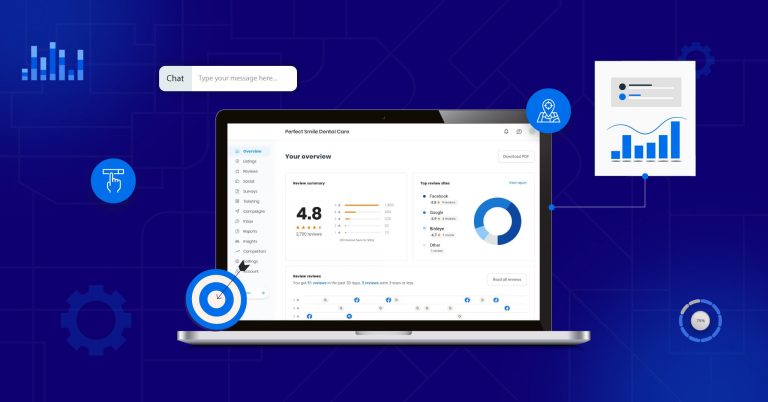Online reviews are no longer just digital word-of-mouth. They’ve become deal-makers or deal-breakers. Customers now evaluate businesses not only by what a brand says about itself, but by what others say about it publicly.
Whether it’s a single-location store or a national chain, a few poor ratings, delayed responses, or unanswered criticism can derail conversions and diminish trust. This is why consistent, structured review management is no longer a reactive task-it’s a core business function.
This article highlights ten critical benefits of adopting review management software-ranging from reputation management and faster responses to better analytics and long-term scalability.

Review management software helps businesses track customer feedback from multiple various directories. This eliminates the need to jump between tabs or log into each platform individually. Instead, everything is consolidated into one streamlined dashboard, enabling teams to stay informed and responsive without duplication of effort.
Real-time alerts keep managers in the loop, while filters and categorization help prioritize urgent or high-impact feedback. Whether you’re a marketing or a store manager, centralized monitoring enables coordinated responses and faster decision-making. It’s the foundation for reputation control at scale.
Speed matters when it comes to online reviews. Responding promptly can prevent dissatisfaction from spreading and signal to future customers that your brand is attentive and trustworthy. Review management software shortens the feedback loop by providing real-time notifications and user role-based workflows. Frontline teams can respond directly within the platform, while templated responses approved by HQ ensure consistency. Automated triaging ensures that high-priority issues get routed quickly to the right teams-whether it’s customer support, operations, or store leadership. This ability to close the loop fast helps prevent escalation, recover dissatisfied customers, and demonstrate brand accountability.
A consistent review response approach helps shape your digital reputation. With review management software, you can amplify the impact of positive reviews and tactfully manage the negative ones. These tools help surface trends-like recurring complaints or praise-and allow you to respond publicly, improving perceptions. Over time, maintaining a steady volume of positive, recent reviews enhances your average star rating and boosts credibility. Equally important is responding in a respectful, professional tone. Software tools help ensure that each response aligns with brand values and tone guidelines. The result is a healthier and more resilient online reputation.
Reviews are a rich source of qualitative feedback. Beyond star ratings, the actual content of customer comments holds valuable clues about what’s working and what isn’t. With online review management tools, businesses can:
Google’s local ranking algorithm factors in review quantity, quality, and frequency. That means businesses that consistently earn and respond to reviews are more likely to rank higher in local search results. Review management software helps you stay active across all your business listings, increasing visibility in Google Maps and other local search results.
Many platforms also integrate with local SEO tools to help optimize listings, track keyword performance, and ensure accurate business information across channels. Over time, this leads to better discoverability, more clicks, and ultimately more foot traffic and conversions.
Maintaining brand consistency across dozens or hundreds of locations is challenging, especially when each outlet interacts with customers independently. Review management software solves this by creating a structured system for response approvals, tone guidelines, and escalation workflows. Teams can track and audit responses, while local teams stay empowered to respond in a timely way.
Dashboards offer location-level insights so you can benchmark performance and identify outliers. Whether you’re a franchisor or regional head, you gain the ability to enforce brand standards while respecting local autonomy-a balance that’s critical for multi-location brands.
When customers see that their feedback is acknowledged, it builds trust. Responding to both positive and negative reviews demonstrates care and fosters brand loyalty. Review management platforms enable teams to follow up with unhappy reviewers and potentially resolve concerns. This proactive service recovery can turn detractors into promoters.
While some platforms rely on aggressive automation, others like SingleInterface offer a more structured, brand-safe approach to growing review volume. Rather than sending unsolicited requests, the platform enables businesses to build intelligent workflows that encourage timely and relevant outreach-such as post-visit thank-you messages or feedback nudges after customer support resolution. Teams can customize when and how review prompts are delivered, using tested templates and guidelines that align with tone and timing best practices.
This localized and controlled method improves not only the quantity of reviews collected, but also their quality-ensuring they reflect real experiences and actionable insights. Structured request mechanisms also reduce the risk of being flagged for spammy behavior on review platforms, which helps maintain long-term credibility and compliance.
Understanding how your brand compares to others in your market is essential for strategic planning. Modern business review software provides benchmarking tools that:
These insights help you gauge where you’re excelling and where there’s room to improve.
What works for 10 stores doesn’t always work for 500. As brands expand, managing reviews manually becomes unsustainable. Review management software supports centralized oversight with localized execution-allowing field teams to act quickly while keeping HQ informed. Features like permission controls, regional dashboards, and automated workflows ensure that no location gets left behind. Additionally, as data accumulates across locations, you build a comprehensive understanding of how reputation impacts business performance. This enables better strategic planning, smarter resource allocation, and long-term consistency.
Review management isn’t just about public perception-it’s about operational improvement, customer intelligence, and long-term growth. The right online review management software turns reviews from a liability into a strategic asset.
It empowers teams to act faster, respond better, and learn more from the voices that matter most-your customers.
Want to see how the best review management software can help you streamline customer engagement across locations? Explore what platforms like SingleInterface offer for scaling your review strategy efficiently.